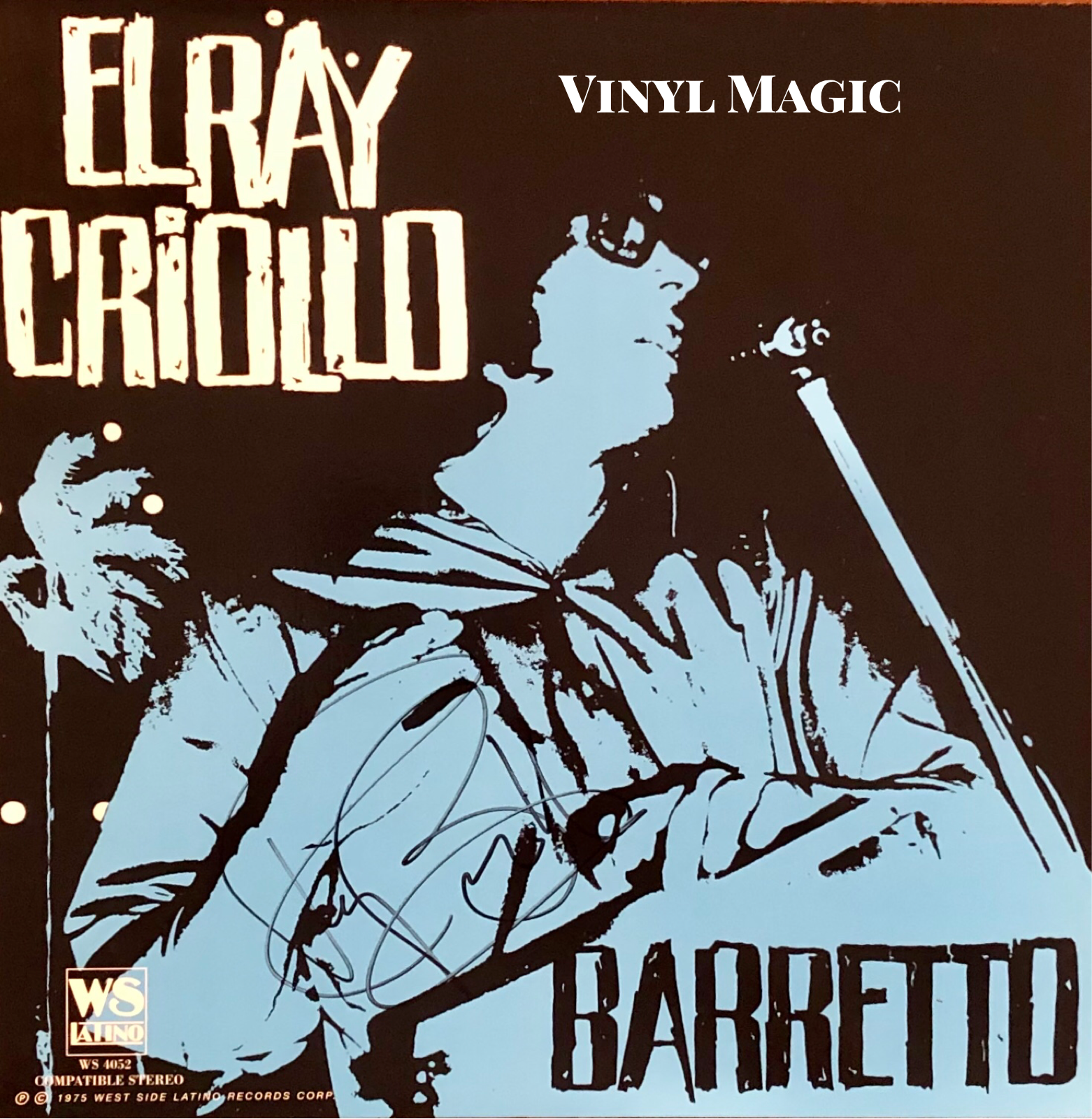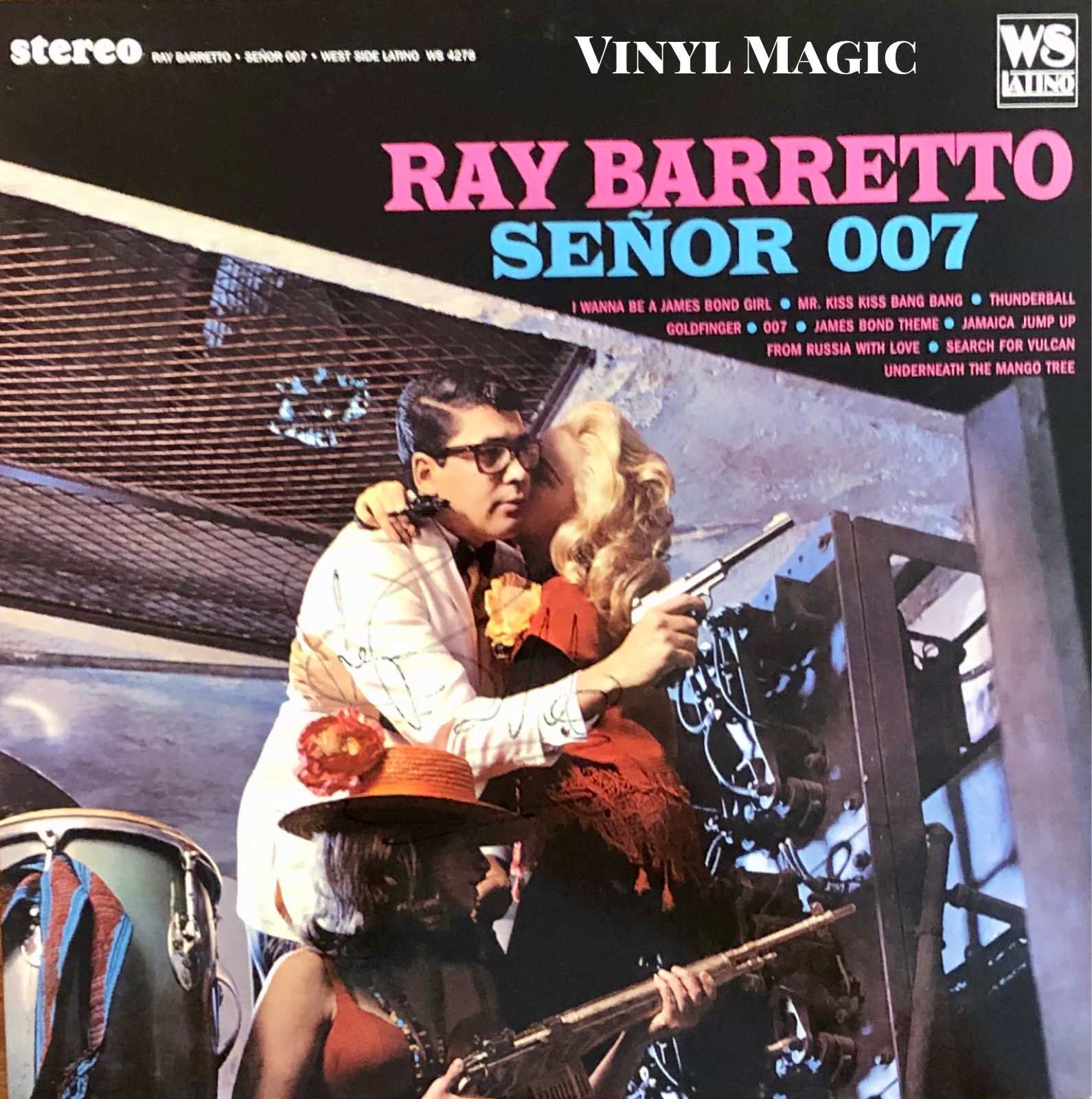Ray Barretto and Me…
Jazz was no accident. I've loved it since I was a kid hearing Louis Armstrong. Salsa was no accident, either, having heard greats like Marcelino Guerra, Machito and Arsenio Rodriguez. I always had the essence of both worlds. I got into the Latin thing more out of economics. In jazz, the conga is not an essential part of the rhythm section, so while I might record with an artist, I never got called for the gig. In Latin music, the conga is an essential, so Latin became a way of earning money.
Ray Barretto
Barretto Para Bailar (1960) signed by Ray
But it wasn't always funning around, at least for me, because while Ray was resting his body, his mind was going full blast with ideas - some simple, some heavy duty. Ray would either call me or send for me with instructions to bring a pencil and music paper, then he would proceed to tell me about whatever idea he had in mind. Ray wasn't just another percussionist, he was a fully-fledged musician who read and understood music in its true form.
pianist/arranger Louie Cruz on Ray Barretto
Guajira y Guaguanco (1964) signed by Ray
I don't carry my own drums anymore, so these days I play pretty much what is put in front of me. But my favorite drums were the ones with the tacked-on mule-skin head that you tuned with Sterno. They had a special organic quality.
Ray Barretto
El Ray Criollo (1966) signed by Ray
It was war on stage, but you learn to get slick. I would follow a band that just left the stage burning, maybe Larry Harlow or Eddie Palmieri, and all the stops were out. They were shooting machine guns everywhere. I would go on stage and start with a son montuno like “Hipocrasia y Falsedad” and cool things down-take it back to basics. You don’t have to follow fire with fire; you can be cool and build it up. Then I’d finish the set with “Que Viva la Musica” or something and have the audience back. But learning to do that came with experience.
Ray Barretto
Hard Hands (1968) signed by Ray
Born in New York City in 1929, Ray Barretto was raised in Spanish Harlem. He was deeply influenced by the big band music of Count Basie and Duke Ellington. He joined the Army in 1946 and, while stationed in Germany, Ray heard "Manteca" on a jukebox, a song co-written by Dizzy Gillespie and Cuban percussionist Chano Pozo. It is one of the first jazz compositions to use the Clave, a 3-2, 6-8, or 12-8 rhythmic pattern which is the basis for many Afro-Cuban jams. "Manteca", slang for marijuana, became a jazz standard. As Ray later acknowledged, "Chano was my first influence. He did not come out of jazz, he was placed there by Dizzy and it was not his natural element ..Chano was a salty, earthy dude and he played like it."
When he returned home from his stint in the Army, Ray said he purchased his "first congas from a bakery on 116th Street in Harlem that used to import drums from Cuba. For 50 bucks you would get yourself a nice drum with a tacked-on head that you heated up with Sterno to get in tune... so you would put the Sterno on the floor and turn the conga over, and it would dry the moisture from the skin and bring it up to pitch. This was before there was a rim on the conga drum. Now you just turn a wrench and it tightens the skin...I used to take those drums and put them on my shoulder and get on the subway, and anywhere between 110th Street and 155th Street in Harlem there were places to jam every night. I spent three, four years just going to jam sessions.”
Midnight Blue (1963) signed by Ray, Kenny Burrell, Stanley Turrentine
In the late 1940s, Charlie Parker heard Ray play at a jam session and asked him to sit in with his band. A couple of years later, as Ray's prowess and renown grew, he joined Tito Puente's band as a conguero (replacing the great Mongo Santamaria), and Ray's beats and rhythms helped propel the band, especially on Tito's Dance Mania (1957) which became a best seller. Ray joined Prestige Records in the late 1950s as a session musician, and he recorded with many jazz artists during this time including Kenny Burrell, Arnett Cobb, Herbie Mann, and Wes Montgomery. Ray and pianist Red Garland (of the John Coltrane Quartet) eventually recorded and released their own version of "Manteca" in 1958.
The Dynamic Duo (1966) signed by Ray, Jimmy Smith
Ray's solo career began in 1960 and continued for the next forty-five years as he released over fifty-five albums as a leader. In 1963, following singles released by Chubby Checker and Smokey Robinson, Ray helped stoke the Watusi dance craze with "El Watusi", a Top 20 hit. Ray began recording for Fania Records, an influential Latin label started by Jerry Masucci and bandleader Johnny Pacheco. His first Fania records, Acid(1968) and Hard Hands (1968) were intoxicating blends of Latin boogaloo, soul and funk.
Acid (1967) signed by Ray
In the 1970s, Ray joined the Fania All Stars which popularized Salsa music in New York City and far beyond, playing sessions with Celia Cruz, Johnny Pacheco, and Charlie Palmieri. Highlights with the Fania All Stars included selling out Yankee Stadium in 1973 and a subsequent live album which featured a 10 minute fiery descarga (jam) between Mongo Santamaria and Ray on "Congo Bongo", and participation in Zaire '74, a three night concert in the beleaguered African nation which was to take place before the Muhammad Ali-George Foreman "Rumble In The Jungle." Unfortunately, Foreman got cut by his sparring partner and the fight was delayed for six weeks, but the concert went on as scheduled and 80,000 grooving music fans listened to James Brown, BB King, Bill Withers, Celia Cruz and the Fania All Stars. Soul Power, a 2008 documentary film, reveals Ray and these wonderful musicians in all their musical glory.
Ray's first love was jazz, and he returned to it in earnest when the Salsa craze peaked in the 80s. He led numerous bands and released many recordings including Homage to Art Blakey & The Jazz Messengers (2003), a tribute to his mentor, friend and fellow percussion genius. Through the years, I saw Ray perform many times in Intimate clubs like the Jazz Standard and Birdland in New York City. He always had wonderful musicians accompanying him, young lions of the Latin jazz scene like pianist Hilton Ruiz, tenor saxophonist David Sanchez, trumpeter Ray Vega and pianist Robert Rodriguez.
Senor 007 (1966) signed (faintly) by Ray
When I met Ray, I was struck by how kind and generous he was. After seeing him hunched over his congas, he was surprisingly tall, and when he clasped my hand, I could feel the calluses and strength of all those years beating on those skins. He smiled when he saw the Senor 007 album cover, draped by a bevy of ersatz Bond girls. He gave me a sly nod when I asked if he had enjoyed this photo shoot. He enjoyed looking through his early recordings (and it is an impressive catalog), but he identified himself mostly as a jazz musician, albeit a famous Latin jazz one.
Perhaps the esteemed producer Orrin Kneephews described Ray best: “He brought a quality as a percussionist that wasn’t about an ethnic thing but more about a beat and feel that added tremendously to those blowing dates. I used Ray on the merit of what he did for Prestige, particularly those Red Garland sessions. This is an excellent player, a man who lends a quality to what’s happening, a broad-based jazz percussionist. One of the important records I did with Ray was with Eddie ‘Lockjaw’ Davis on Afro Jaws. The use of a horn background with Lockjaw was an unusual thing. He was a funk player, but we put him in an African-Latin mode and he brought a quality to it like nobody else.“
Ray Barretto, a fabulous musician, songwriter and band leader, his beats and rhythms sustain.
Carnaval (1974 reissue of Latino! and Charanga Moderna) signed by Ray
Choice Ray Barretto Cuts (per BKs request)
https://www.youtube.com/watch?v=Mhq5cmJG61Y
“Acid” Acid 1968
https://www.youtube.com/watch?v=3uZx9KnlTyg
“El Watusi” Latin Soul Man 1962
https://www.youtube.com/watch?v=1C7cfAaoBVQ
“Mi Ritmo Te Llama” Hard Hands 1968
https://www.youtube.com/watch?v=LOwaoOSLtFQ
“Fever” live in France 2000
https://www.youtube.com/watch?v=W6kagefW6zc
“Ban Ban Quere” live 1970s
https://www.youtube.com/watch?v=-A2Wwyuqa6g
“El Negro Y Ray” Carnaval 1963
https://www.youtube.com/watch?v=ZCLeS1ICPuo
“Indestructible” Indestructible 1973
https://www.youtube.com/watch?v=i0MTTTOB8nQ
“Start The World I Want To Get On” live with Charlie Palmieri
https://www.youtube.com/watch?v=Bstf--ymw20
“Ritmo En El Corazon” Ritmo En El Corazon 1988
https://www.youtube.com/watch?v=W777MIR8-ko
“Guantanamera” Live in Zaire with Celia Cruz 1974








